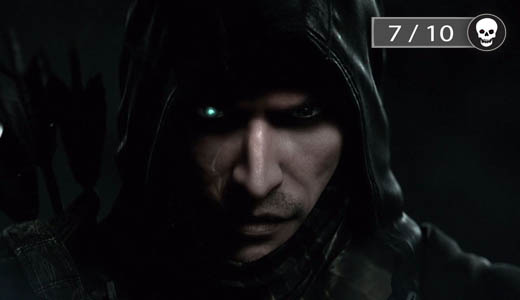Square Enix continues to mine the Eidos back-catalogue dragging classic franchises kicking and screaming into the ‘10s. Deus Ex, Hitman and Tomb Raider have all previously had a polish up.
Now it’s the turn of the classic stealth game, Thief.
In a similar way that they did with Deus Ex: Human Evolution, developer Eidos Montreal has taken some of the characters and the essence of the original games and produced a new take on an old idea. As before, players take on the role of the thief, Garrett.
As the game opens, in a craftily disguised tutorial sequence, we join Garrett as he negotiates the rooftops of The City, eventually meeting up with his headstrong protégé, Erin, to steal an object called the Primal Stone.

As they both head out to their prize, the banter between the two rogues reveals Garrett’s disapproval of the two younger thief’s more violent methods. Their argument reaches its peak at their destination, on top of a glass rooftop, as a group of robed figures engages in a ritual with the Primal Stone below. As Erin goes to collect her weapon, she is thrown into the center of the roof during her scuffle with Garrett and the roof collapses. Despite Garrett’s efforts to pull her up, Erin falls into the maelstrom of light below. The resultant explosion renders Garrett unconscious.
When Garrett awakens he finds that a year has passed and the city is under the veil of a deadly plague called The Gloom. As well facing starvation and certain death, the people are being terrorised by the Baron’s Watch and the threat of revolution is in the air.
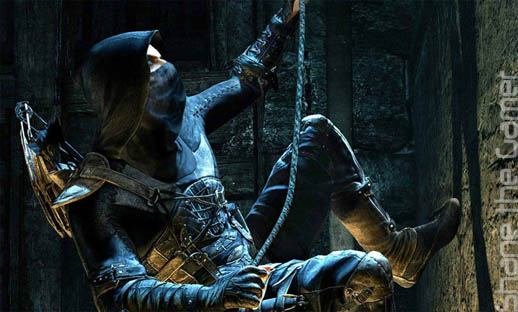
If that sounds at all familiar it’s because it’s pretty-much the same setting as Arkane’s Dishonored. Interestingly, Dishonored itself borrows heavily from Bioshock– a game from the mind of Ken Levine, the same guy responsible for the original Thief. What goes around comes around, I suppose, but come on Eidos Montreal, you could’ve tried to be a little more original.
Whilst not the throwaway story it could have been, Thief’s plot is a little uneven, being mild fantasy adventure that plays itself very straight before descending into the weird. But it does serve to introduce us to Garrett’s home, The City.
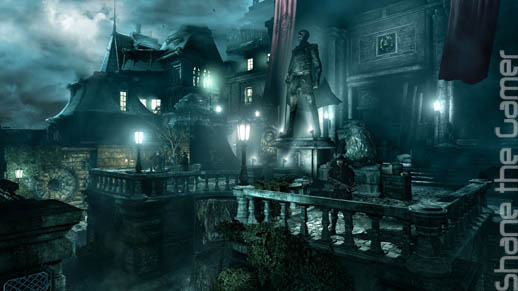
The developers have tried to make The City is as much a character in the game as anyone else that you will meet; it’s like a medieval Gotham City, part-gothic with a hint of steam-punk. It’s a city that is always night for the player- which is handy when looking for shadows to sneak about within.
Just as its predecessors were, Thief is a 99% stealth game. Taking on the enemy in a direct confrontation is near-suicidal. You need to avoid guards or take them down from behind or from above. Even then, a trail of bodies will raise alarms if discovered. There are also plenty of sequences where you must remain unseen, whereby discovery will result in mission failure.
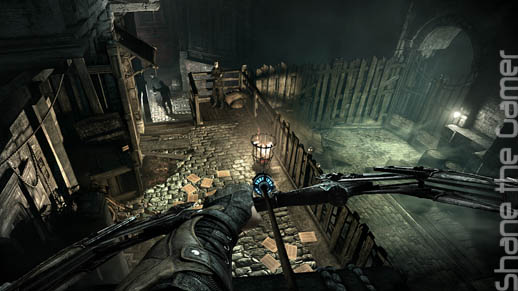
Garrett’s stealth antics may put off the more gung-ho players out there. I’m not the world’s number-one stealth fan, preferring at least the option to go out guns-blazing if it all goes tits-up. Despite Thief’s rather unforgiving stance towards cavalier behaviour the game’s stealth mechanic was never frustrating.
There were times, especially early on, where I really couldn’t see a non-violent solution. This inevitably resulted in an unwanted confrontation with the guards. I don’t know if it’s by design, but there’s no satisfaction to be had engaging guards in melee combat.
It feels like an act of desperation and if you survive the encounter you feel more like a failure than victorious. It’s much cooler to just sneak by enemies.
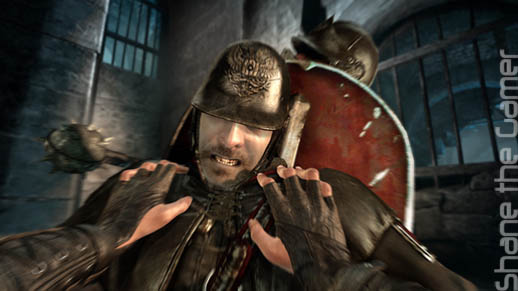
Sneaking in Thief is more than just sticking to the shadows, running across rooftops or hiding in closets- all of which you are free to do. Garrett can also peek through keyholes – nothing worse than opening a door into a room full of guards – and curtains. My favourite has to be peering around corners, which feels very organic and has a neat depth of field blurring effect.
You can also make your own shadows by extinguishing candles with your fingertips and using water arrows to put out torches. My generally impatient demeanour meant that I didn’t use these aids as much as I should have, often with disastrous results.
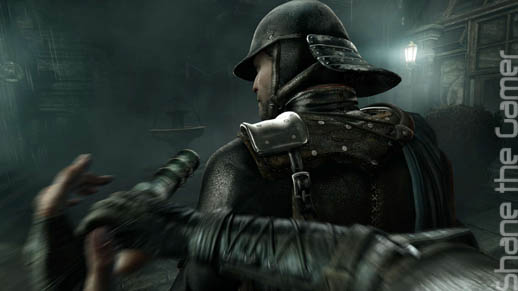
The game bought out my inner kleptomaniac and had me checking every drawer for shiny things. I found it difficult to resist the tell-tale glimmer of loot, even if it meant going out of my way and risking discovery from the nearby guards.
You soon realise that stealing random items is necessary in order to proceed in the game. Without stocking up on supplies it is very difficult to succeed and Garrett needs cash to buy stuff. Your purloined trinkets are as good as currency in The City and can be traded for equipment and consumables.
Garrett’s primary weapons are his blackjack for up close and personal, and his bow.
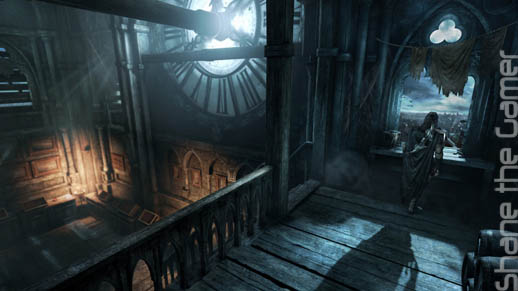
There a number of arrows available, most of which are non-lethal. Water arrows put out fire, blunt arrows can be used to break objects. The more aggressive arrows, choke, fire, blast, broadhead and sawtooth range in effectiveness from stun to kill, but apart from a direct hit with a blast arrow, you can never guarantee that your target will end up unconscious. Garrett also has rope arrows for firing a line to reach high places and some neat flash bombs to aid a hasty exit.
As the game progresses, Garrett obtains other thievery equipment in addition to his trusty lock picks.
Wire cutters are handy for disarming traps, which you will stumble across in the course of the game. There are a number of shiny plaques on many of the buildings that required a wrench to successfully purloin- it can also be used to open grates to access new routes thought the environment. When you get hold of the razor you can start your artwork collection by cutting paintings from their frames.
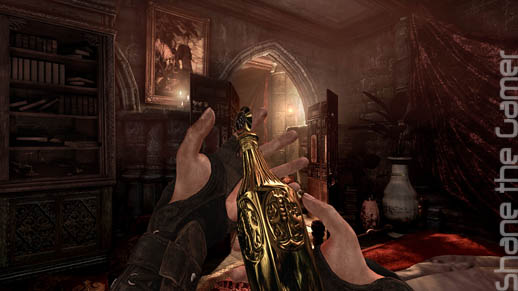
There are a number of special items dotted around the city which when obtained get displayed in Garrett’s clock tower lair. The clock tower also serves a game hub where players, store items or equip themselves after every mission.
As well as sneaking about and stealing things, Garrett also comes across some interesting puzzles. They’re not overly taxing, but will require a bit of thought putting the clues together. It’s actually nice to play a game that doesn’t lead you by the nose or provide excessive hints.
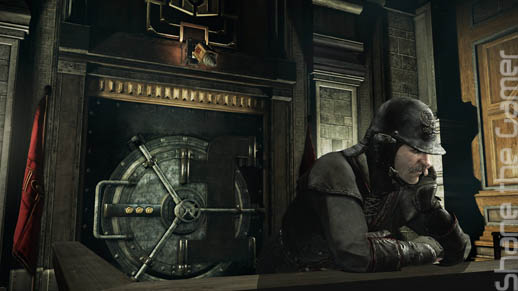
The game is mission based, but granting players the freedom to wander around the city breaking into random houses or taking on client’s side missions. The City is vast, but far from being open-world. It’s split into districts that are in themselves pretty linear.
As your abilities increase you can negotiate them in different ways, but they are really open-air corridors masquerading as open environments. It is identical to the compartmentalised environments that the same studio employed for their Deus Ex: Human Evolution.
If I can fly from one end of San Andreas to the other in GTAV on an Xbox 360, I should be able to scamper through Thief’s city without negotiating obvious zone points and loading screens. The game could do with a fast-travel option, as making your way across the labyrinthine city just to buy some supplies starts to become a chore after a while.
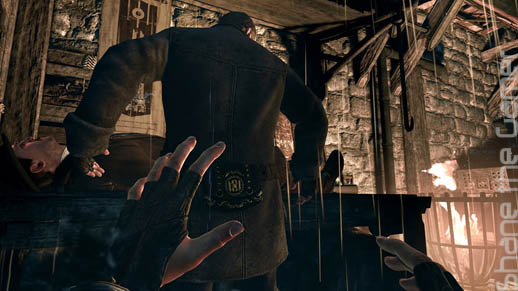
The actual campaign missions are very well structured, offering players multiple routes and thus multiple ways of tackling the Levels. Cupboards are placed at strategic positions and they serve two functions, the first being a place to hide. Their secondary function is as an autosave point; every time you enter a cupboard the game saves. Worth noting, especially if you have the sudden urge to go all gung-ho.
At the end of each mission the game provides a summary of your performance. Your play-style is rated in terms of ghost, opportunist and predator; depending on how stealthy you were, how much you used the environment and how you dealt with guards. There’s also a run-down of your stats giving percentages for the amount of loot stolen and special items found. If you are at all disappointed by your performance there’s a button to restart the mission.
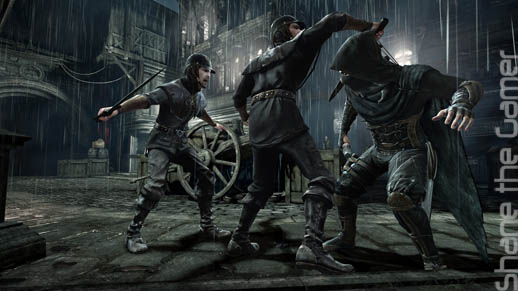
The City is sparsely populated, even for night time. Whilst the handful of fleshed out supporting characters do the job – especially the fantastically monikered Thief-taker General, there’s little to like about the leading man; Garrett’s character is paper-thin.
He’s a thief and he’s pretty serious about it, but he isn’t a lovable rogue in any way. He doesn’t have a higher purpose. He steals things because it’s in his blood. He also looks…well, kind of ill. It’s a bit of a missed opportunity as they could have gone somewhere with Garret, like Ubisoft have with Edward Kenway in Assassin’s Creed V.
Still, Garrett is an able thief and fun to play. As well as a keen climber he has his own special abilities which players can trigger by entering focus mode.
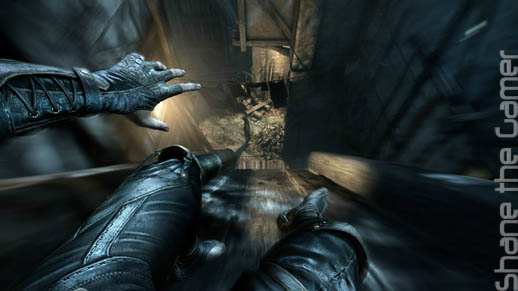
When activated Garrett can see interactive parts of the environment, such as switches, grates and traps. Focus also makes Garrett a bit more stealthy. As the game progresses focus points are unlocked adding and upgrading new abilities making him quieter and more durable. Using focus depletes the focus meter which can be filled by consuming special poppies.
Garrett’s other meter is for his health. Garret’s health reduces when he gets hit, falls or is poisoned. Food restores health and like most consumables in the game can either be purchased or found lying about.
The game is packed with things to do.
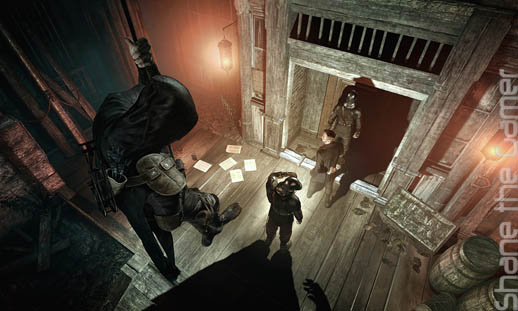
As well as the main story missions you can pick up extra tasks from clients or from your associate Basso.
The game is also littered with documents, providing information and backstory, amongst the treasures and trinkets. Most of the side missions are a bit weak, usually involving robbing an empty house protected by a solitary trap, if you are lucky, and a combination safe. It’s a shame that they couldn’t have had a bit more depth. The hardest part of these optional missions was finding a way through The City to get to them.
The game has a fair amount of replayablity not only by having another go at the individual missions, but also trying out the game’s challenge mode.
There’s a few challenges based on a couple of the environments in the main game, whereby players have to collect loot unlocking score multipliers against the clock. Very similar to Hitman’s contracts, they are a nice diversion from the campaign.
Whilst I had a lot of fun playing Thief, it is far from perfect.
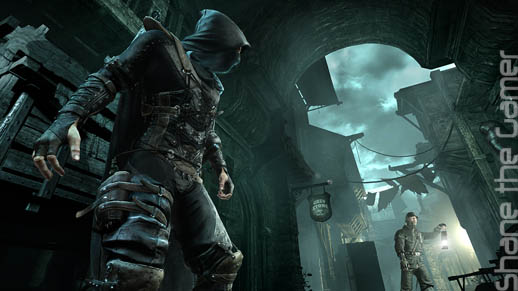
During my review play-though some questionable design decisions stuck out like a sore thumb. I’ve already covered negotiating the city, but that’s not the end of it.
The over-use of generic sequences should be considered a cardinal sin in modern games. If developers want to keep players immersed, repetitive and predictable game mechanics should be avoided.
For instance, if Garrett has to slip through a tight space there’s always a timber rafter that needs to be moved out of the way. Even in the spooky asylum, among the forest of upended bedsteads, there was a familiar timber rafter waiting to be pushed out of the way. It’s a lazy mechanic that adds absolutely nothing to the gameplay experience.
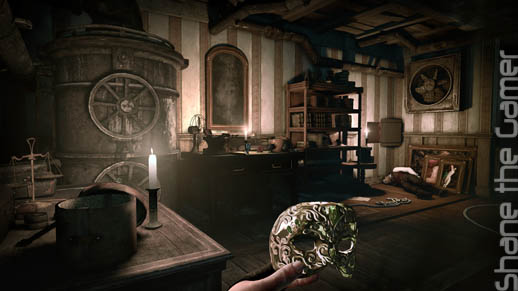
Like most of the games that have come out of Montreal-based studios over the past few years, Thief isn’t immediately engaging. Like the Assassin’s Creeds and the Deus Ex reboot, Thief is born from a melting pot of gaming ideas that seem to have been developed in isolation and then clumsily bolted together to form the whole.
It’s like it’s designed using psychology, pressing the right buttons inside the gamer’s brain, rather than any sort of craft. The result is a good gaming experience but lacking any sort of soul.
I was warned that the pre-release review build of the game did have some minor issues. Even so, I noticed a few things that I feel that I should mention, as I’m not sure if they’ve been fixed in the retail release.
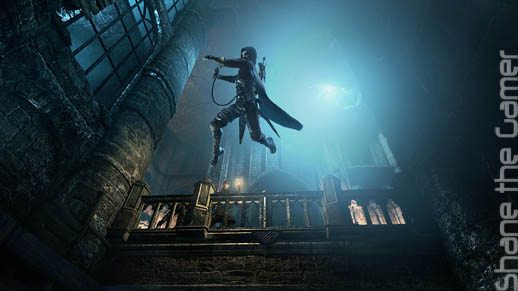
For starters the audio is all over the place, which is a nightmare for a stealth game. Ethereal voices that sound like they are right next to you shout out into the night and lone figures seemingly converse with invisible companions. I also encountered a few other minor graphical glitches such as guards spinning like something out of The Exorcist and woman whose dress disappeared revealing an unnervingly disembodied set of limbs.
Thief is a great game to look at. The City’s architecture is there to be marveled at. The attention to detail is astounding, every nook and cranny packed with details and things to steal.
Eidos Montreal have opted to use the Unreal Engine for the visuals, the result is a bit meat and potatoes, with some pretty average lighting. It does the job, though and should run fine on most sensibly spec’d systems (PC).
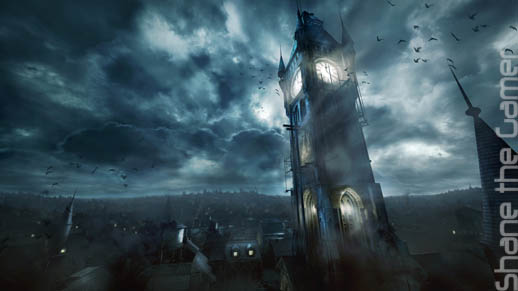
Thief is an odd one. It’s got masses of potential, but falls short in so many ways.
The oddly compartmentalised city would have been fantastic if only it was open world. As a character Garrett fell a bit flat, but the plot was OK, if a bit off the rails in places.
I did, however, enjoy playing the game.
The puzzles were good and the whole package was intriguing enough to keep my interest. But it could have so easily been so much better.
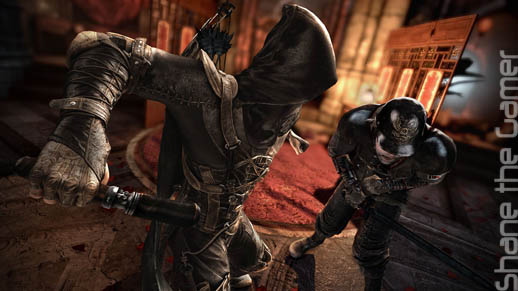
At the end of the day, Thief made me want to go and play Hitman, Dishonored and Tomb Raider again- all games that succeeded where Thief only got it part right, and that’s really not good.
Thief is a game that I would recommend to fans of the genre (and / or the original game) only on the understanding that, as entertaining as the game is, they will have played others that did it so much better.
[jwplayer player=”1″ mediaid=”6497″]


